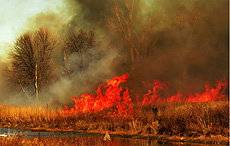"Big" sustainability
 |
| A prescribed prairie fire, one of many land management techniques that mimic natural processes and maintain high-quality, diverse ecosystems, is a familiar sight at Fermilab. Photo: Fermilab Roads and Grounds |
We are talking about the concept of "sustainability" more than ever these days, and the quotation marks around the word underscore the difficulty in understanding just what is meant by it. At its simplest, sustainability means managing resources now in a way that allows them to be replenished in time and in quantities sufficient to serve the future. It's sort of like not spending money faster than we make it.
Measuring sustainability usually focuses on energy and water conservation, recycling and reusing materials, and minimizing waste. If we value large, diverse biological ecosystems, we ought to strive to preserve them for the future. Conservationists know that the quality of the resources that we manage to preserve for future generations is as important as the sheer quantity. It is important to measure ecological resources carefully so as to include their qualitative as well as quantitative aspects.
Since Fermilab was built, the surrounding area has been developed into intensive residential, commercial and industrial activities. So if "open" or "green" space is a measure, we can claim a degree of success in that Fermilab's presence has preserved open space for the use of future generations.
But here is where the notion of quality becomes important. To the extent that the Fermilab site is an ecological entity, it's fair to ask about the quality of the green space. Over the years, Fermilab's land managers have evolved a stewardship philosophy in which the undeveloped resources of the site are managed in a more "natural" way to maximize the aesthetic and ecological values of the site.
That turns out to have some valuable side benefits. In many cases this approach to management is cheaper than more traditional, energy- and chemical-intensive and destructive methods. Another is that the resources after years of this approach to management are of higher ecological quality than they were 40 years ago.
The reconstructed tall-grass prairie on site is an example of how this management strategy can result in the preservation of not just open space, but a space that is biologically diverse, provides us and those in the future with ecological services, preserves the intrinsic values of natural ecosystems, and honors the natural history of the land where we are located. After all, before European settlers came to this area, about 1830 or so, the area was a rich mosaic of grasslands that reached from the prairies of the Dakotas and Iowa to lush wetlands and oak savannas.
So what does this have to do with sustainability? I'm suggesting that we think of sustaining not just the land, but also the quality of the ecological systems in it, and not just for its own sake, but for the use and enjoyment of future occupants and visitors of the Fermilab site.
—Rod Walton
|